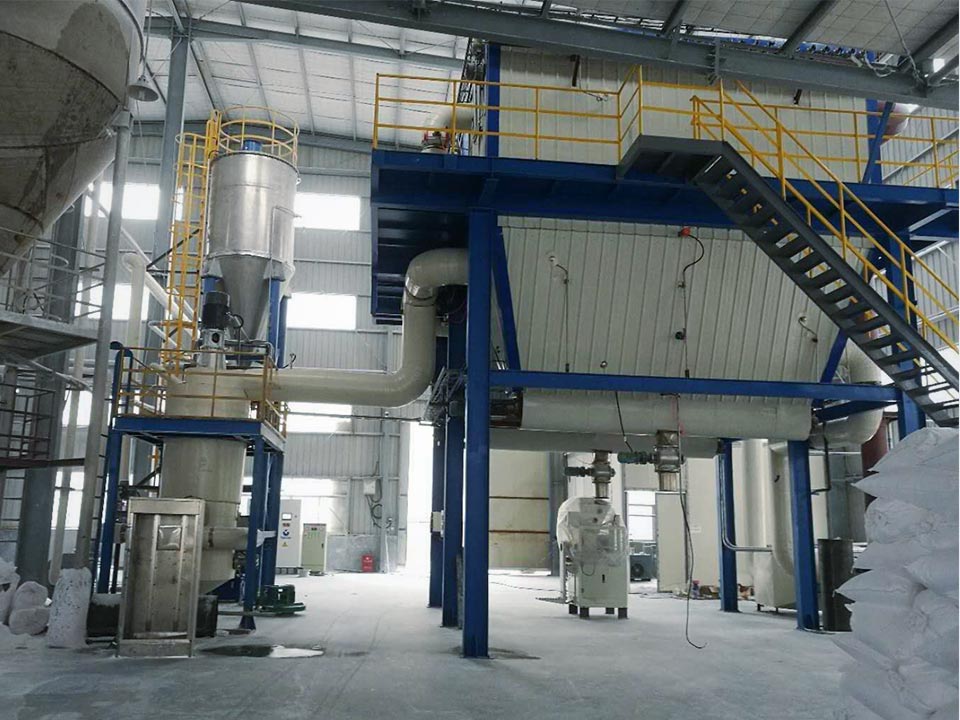Application status and prospect of jet mill
Jet mill, also known as jet mill, refers to the equipment that uses the energy of high-speed airflow (300~500m/s) or superheated steam (300~400℃) to make particles collide, collide and rub each other to achieve ultrafine grinding. Compared with other types of shredders, it has the following advantages:
① Good product granularity. The average particle size (d50) of the material is generally below 5μm, and the particle size distribution is narrow. ②The product has high purity, especially suitable for the grinding of materials that are not allowed to be contaminated, such as medicines. ③It can crush low melting point and heat sensitive materials. ④The product has high particle activity. ⑤The production process is continuous and the production capacity is large.
Jet mills also have some shortcomings, such as: high equipment manufacturing costs, high energy consumption, and large processing costs; single machine processing capacity is poor, not suitable for large-scale production; product particle size is difficult to reach sub-micron level, when it is below 10μm The output has dropped drastically, and the processing cost has risen sharply.
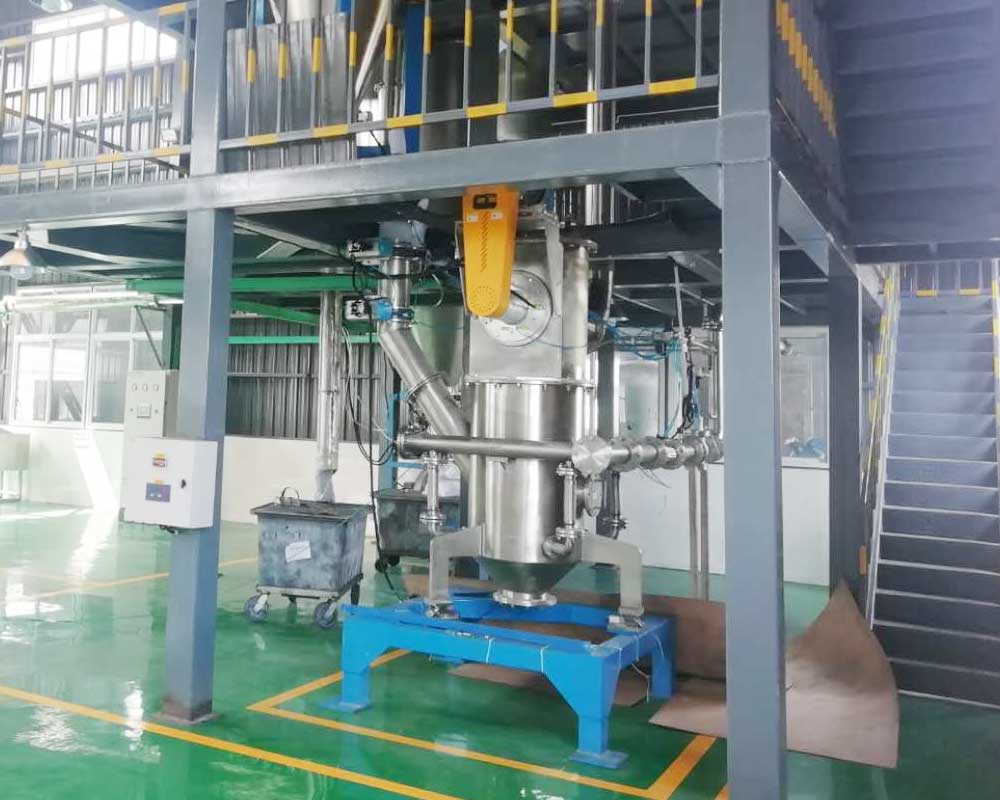
Ultrafine powder technology is an emerging technology. According to the depth of powder processing technology and the changes in powder physical and chemical properties and application performance, the powder with a particle size of less than 10μm is usually called ultrafine powder.
The development of modern engineering technology requires many raw materials and products in powder form. For example, in the military, aerospace, aerospace, and electronic fields, the use of ultrafine powder can be used to make stealth materials; in the chemical industry, the ultrafine catalyst can increase the rate of petroleum cracking by 1 to 5 times; after the ultrafine grinding of drugs, the The surface energy is greatly increased, which improves the effectiveness of the medicine and is beneficial to the absorption of the human body.
Ultra-fine grinding equipment can be divided into different grinding methods: mechanical impact mill, vibration mill, jet mill, stirring mill, etc.
Application status of several ultra-fine jet milling equipment at present
(1) Collision jet mill
This kind of jet milling equipment is also often referred to as a counter-jet jet mill. It uses two high-speed airflows to entrain the particles to be crushed to collide with each other to achieve the grinding effect. It has a high energy utilization rate. It can effectively prevent the jet mill from being damaged due to high-speed impact and can solve the problem of being contaminated by grinding particles.
The advantages of this equipment are mainly reflected in: fast crushing speed, strong impact force, low energy consumption and so on.
(2) Flat jet mill
An early-developed jet mill is a device that uses the collision, shear and friction between particles and the inner wall of the crushing chamber to achieve grinding. Its main component is a disc crushing chamber, several (6-24) high-pressure working fluid nozzles, jet feeders, finished product traps, etc. arranged on the spray ring at a certain angle to the plane of the crushing chamber.
This model is simple in structure, easy to operate, and has a self-classification function, which is especially suitable for the crushing of brittle and soft materials. The outstanding shortcoming is that the grinding cavity is severely worn, which causes certain pollution to the product, and the limit particle size is relatively high.
(3) Fluidized bed jet mill
The working principle of this kind of pulverizing equipment is: adding materials to the pulverizing equipment, using two-dimensional setting of multiple nozzles to spray the impact energy, and the suspension and tumbling collision and friction generated after the expansion of the airflow to achieve the pulverizing effect. The upper airflow near the junction is graded by the grading device at the top under the influence of the negative pressure airflow, and the fine powder is discharged. The coarse powder will be affected by gravity and return to the crushing area to be crushed again.
The advantages of this equipment are mainly reflected in the good dispersion effect, the product size can be adjusted by the classifier, and the wear and energy consumption are relatively small, which is more suitable for large-scale industrial production.
(4) Impact ring jet mill
Replacing the fixed impact component with a rotatable impact ring can avoid the local wear caused by high-speed airflow or gas-solid flow in the previous two types of jet mills under the influence of continuous impact on a fixed position, prompting all positions on the overall ring surface Acting as the impacted surface in turn, the overall annular surface will be subjected to relatively close impact wear, which can promote the life of the impact ring to be extended as much as possible.
The main advantage of this equipment is that the direction of movement of the impact ring is opposite to the jet flow, so the relative speed can be increased, which helps to enhance the grinding effect.
(5) Circulating jet mill
JOM circulating jet mill is mainly composed of O-shaped circulating tube, high-pressure working fluid nozzle, venturi tube and feeding ejector. After the material enters the circulating pipe, the material is ground through friction and collision between the particles and the pipe wall.
Although this model is small in size and large in production capacity, it has serious wear on the pipe wall and is not suitable for grinding materials with high hardness and high purity. It usually requires the use of super hard and high wear-resistant materials (corundum, super hard alloy, etc.) ) As a lining.
The development trend of ultra-fine jet milling equipment in the future
At present, the research and development and manufacturing of ultra-fine jet milling equipment have been greatly developed, and have made important contributions to the powder industry, but there are few large-scale, specialized, high-purity, ultra-fine products that can be produced.
(1) Strengthen basic theoretical research and optimize process flow
Strengthen basic theoretical research to guide independent innovation and development of equipment, and on the basis of existing equipment, vigorously develop research on process optimization and optimize process flow. For mass-produced powders, special models can be developed in a targeted manner.
(2) Increase the output of a single machine and reduce the energy consumption per unit of product
With the increasing market demand for ultrafine powder products, especially the increase in large-scale users and the increasing requirements for product quality stability, the market demand for large-scale equipment continues to rise. Large-scale equipment can more effectively adapt to the development trend of gradual expansion of ultra-fine powder processing, and it also has many advantages such as low energy consumption per unit product, excellent product quality stability, and convenient management.
Application field of jet mill
Jet mills are widely used in chemical, mining, abrasives, refractory materials, battery materials, metallurgy, building materials, pharmaceuticals, ceramics, food, pesticides, feed, new materials, environmental protection and other industries and the ultra-fine grinding and dispersing of various dry materials And particle shaping, it has a wide range of uses.
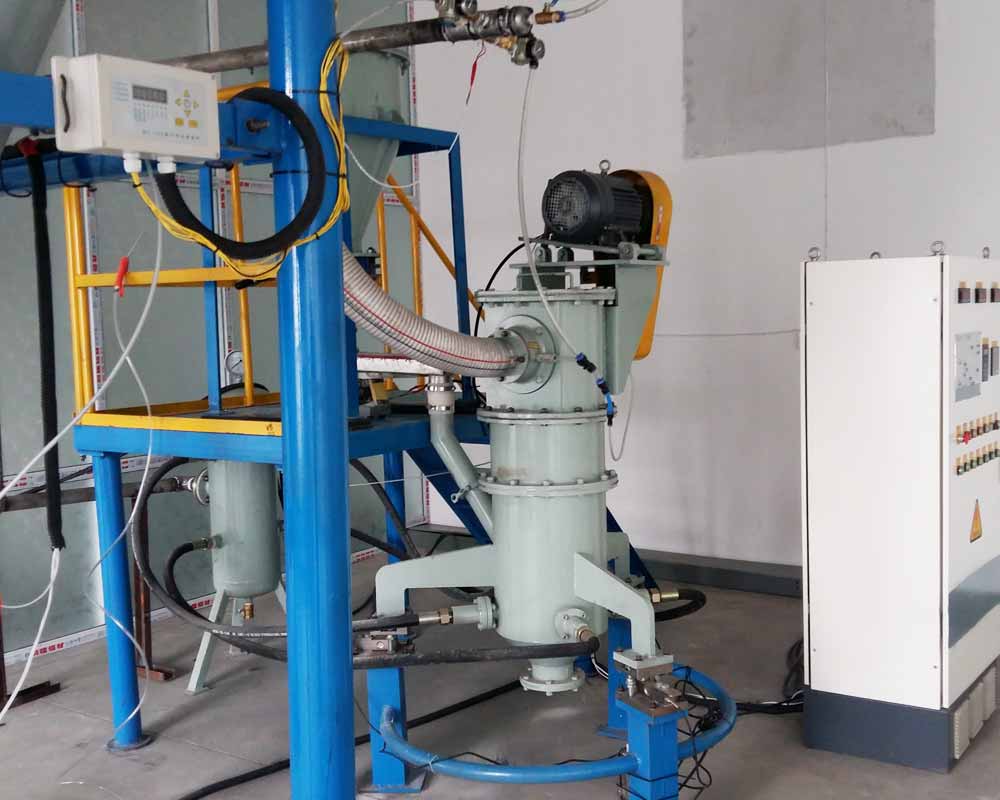
1. Chemical industry:
(1) The ultra-fine catalyst can increase the oil cracking rate by 1 to 5 times;
(2) Chemical fiber, textile, increase smoothness (addition of titanium oxide, silicon oxide);
(3) Rubber, strengthening, lightening, anti-aging (calcium carbonate, titanium oxide);
(4) Coatings, dyes, high adhesion, high performance;
(5) Daily chemical industry, cosmetics, toothpaste, etc.
2. Biology and medicine:
(1) Submicron and nano injections;
(2) Drug refining and enhanced absorption rate (superfine calcium);
(3) Health care products are refined to increase the absorption rate;
3. Military, aviation, electronics, aerospace and other fields:
(1) Super hard, impact-resistant materials, ceramic powder, hard plastics (light weight);
(2) Ultra-fine silicon oxide, high-performance resistance material;
(3) Ultrafine iron oxide powder, high-performance magnetic material;
(4) Ultra-fine oxidizers and explosives, the burning rate is increased by 1 to 10 times;
(5) Superfine graphite, high-performance picture tube and electronic countermeasure materials.
4. Food processing industry:
(1) Fiber food rations, wheat bran, oat hulls, corn germ residue, soybean hulls, rice bran, sugar beet residue and bagasse. After the compressed air of the fluidized bed pulverizer is frozen, filtered and dried, it forms a supersonic airflow through the nozzles and is injected into the pulverizing chamber to fluidize the material. The accelerated material merges at the intersection of the jet airflows of several nozzles, resulting in violent The collision, friction and shearing of the particles can achieve ultra-fine grinding of the particles. The ground material is transported to the impeller classification area by the rising airflow. Under the action of the centrifugal force of the classification wheel and the suction force of the fan, the coarse and fine powder are separated. The coarse powder returns to the crushing chamber according to its own gravity and continues to be crushed. The airflow enters the cyclone collector, the fine dust is collected by the bag filter, and the purified gas is discharged by the induced draft fan.
(2) Micropowders such as calcium supplement foods, animal bones, shells, skins, etc. are easier to be absorbed and utilized by the human body than inorganic calcium;
(3) Chitin, crab shells, shrimp shells, maggots, pupae and other ultra-fine powders. The all-ceramic mechanical crusher is a combination of similar crusher technologies at home and abroad, and has the advantages of impact crushing and hammer crushing. The new type of fine crushing and coarse grinding products developed by optimizing the main technical parameters have the characteristics of large crushing ratio, low energy consumption, stable operation, simple structure, and convenient operation and maintenance. The jet mill is a truly multi-purpose, high-efficiency, low-cost new type of grinding equipment.
(4) Soft drinks can be processed by adopting airflow micro-pulverization technology. It can develop soft drinks such as powdered tea, soybean solid beverages, superfine bone meal, and prepare calcium-rich beverages and instant mung bean flavors.
What factors will affect the working efficiency of the jet mill
Jet mill is a device that uses high-speed airflow for grinding. After compressed air is filtered and dried, it is jetted into the grinding chamber at high speed through Laval nozzles. At the intersection of multiple high-pressure airflows, the materials are repeatedly collided, rubbed, and sheared to be crushed. .
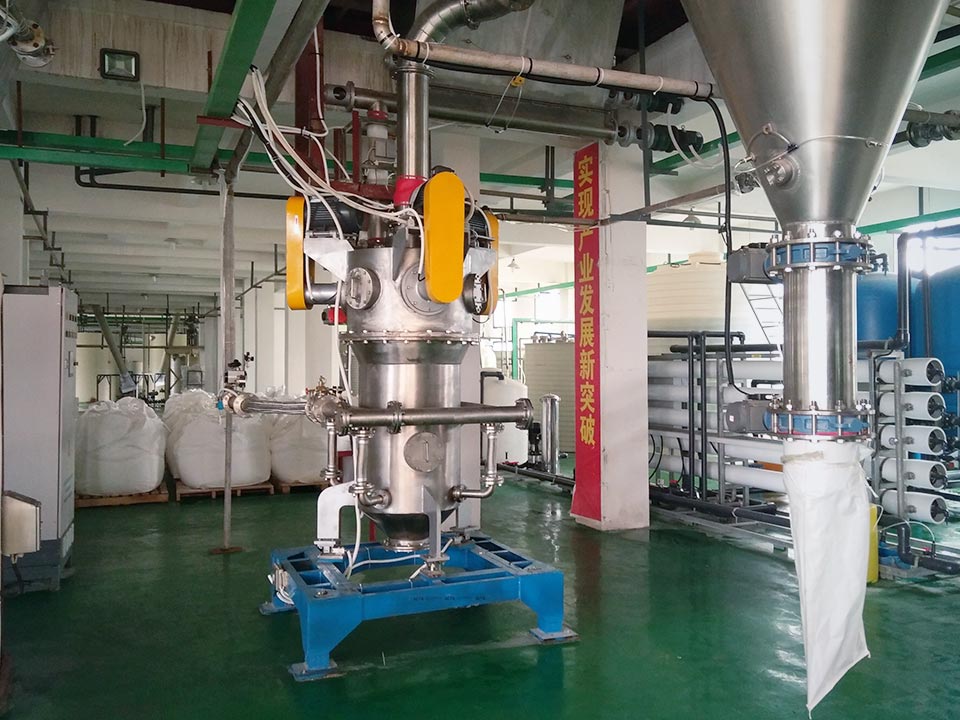
There are several factors that affect the working efficiency of the jet mill.
1. Material characteristics. Generally speaking, the jet mill can be adapted to the crushing of all brittle materials. However, due to the different properties of the materials, their crushing performance is also different. Due to the difference in the strength, density, hardness, viscosity, shape and electrical properties of various materials, the difference in grinding results is inevitably caused, and the strength of the material is an important factor. In addition, because the moisture content of water or oil in some materials or air sources is too high, the properties of the abrasive material (such as the increase in toughness and viscosity) will affect the fineness of the grinding.
2. Processing volume, the same material has different grinding fineness due to different processing volume. Generally speaking, the processing capacity is directly proportional to the particle size of the product. However, if the processing volume is too small, the chance of collisions between particles will be reduced, thereby affecting the fineness.
3. The influence of back pressure, the back pressure is the average pressure of the gas in the crushing chamber. Since the spray speed of the crushing nozzle is mainly determined by the difference between the nozzle inlet pressure and the outlet pressure, the greater the pressure difference, the greater the flow rate. Therefore, the increase in back pressure is not conducive to polishing. In production, the increase in the resistance of the capture system will increase the back pressure of the jet mill and affect the grinding effect of the powder. Therefore, be sure to check the resistance of the capture system.
The difference between open-circuit jet mill and closed-circuit jet mill
Jet mill is a kind of micron level ultra-fine grinding equipment, which is more common in various powder industries. The jet mill has two different structures, divided into open-circuit and closed-circuit. The open circuit system usually refers to the use of air as a medium to crush, filter and discharge after crushing. The closed-circuit system refers to the use of inert gas as the medium. The materials in the system are under the protection of inert gas during the entire process of feeding, crushing, grading, conveying, separating and packaging. After dust removal and filtration, the inert gas is returned to the front-end system for recycling.
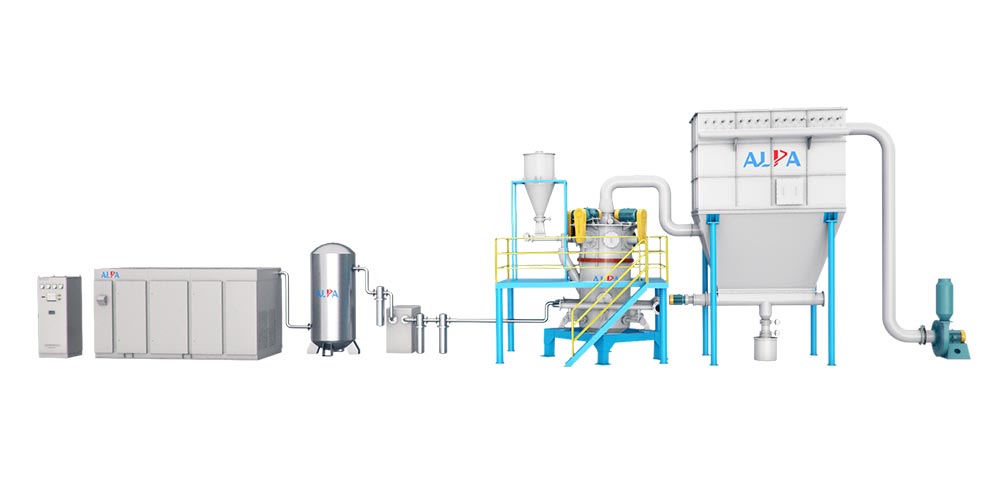
1. Open-circuit jet mill
Jet mill (fluidized bed jet mill) is the compressed air accelerated by Laval nozzle into supersonic air flow and then injected into the crushing zone to make the material fluidized (air flow expands into fluidized bed suspension boiling and collides with each other), so Each particle has the same state of motion. In the crushing zone, the accelerated particles collide and crush at the intersection of the nozzles. The crushed materials are transported to the grading area by the ascending airflow, and the fine powder that meets the particle size requirements is screened out by the grading wheel, and the coarse powder that does not meet the particle size requirements is returned to the crushing area to continue pulverization. The qualified fine powder enters the high-efficiency cyclone separator along with the air flow and is collected, and the dust-containing gas is filtered and purified by the dust collector and then discharged.
2. Closed-circuit jet mill
The closed-circuit jet mill generally refers to the air jet mill based on the air outlet of the pulse dust collector connected with the air inlet of the air compressor that provides the power source of the system to form a closed system to make the smashing medium of the entire pulverization process ( Air or inert gases such as nitrogen, argon, helium, carbon dioxide, etc.) circulate in a closed system.
The closed-circuit jet mill is a closed-circuit jet pulverization system developed for the crushing requirements of special materials such as flammable, explosive, easy to oxidize, and volatile. It is protected by inert gas circulation. The working process is that the cooled inert gas is accelerated by the Laval nozzle into a supersonic airflow and sprayed into the central crushing area of the pulverizer. The sonic airflow brings the animal material to collide with each other in the crushing area to achieve the goal of crushing. The crushed material enters the classification area with the updraft, and the powder material that meets the particle size requirements is sorted by the classification wheel in the classification area. The particle size of the powder is sorted by adjusting the speed of the grading wheel. The sorted products are discharged from the centrifugal separator along with the airflow or collected after being filtered by the dust collector. The unqualified ones continue to return to the crushing area for two Smashed. The filtered inert gas is compressed and recycled by the compressor system, and the whole process is automated.
The open-circuit jet mill can be used for the processing of most common powder materials, and the closed-circuit jet mill is mainly used for flammable, explosive, and oxidizable raw materials. The user can choose according to the raw materials and processing requirements.
Detailed description of jet mill
The jet mill is a device that uses high-speed airflow to achieve ultra-fine grinding of dry materials. It has a high full utilization rate of jet energy and has significant performance advantages such as no heating, no pollution, low wear and high precision. It is widely used in ultra-fine crushing of low-temperature, high-purity and high-hardness materials. For materials that are flammable, explosive, and easy to oxidize, inert gas can be used as a medium to achieve closed-circuit crushing, and the inert gas can be recycled.
The jet mill is composed of a jet mill, cyclone collector, dust collector, induced draft fan, electric control cabinet and other parts of a complete set of crushing system. After the compressed air is filtered and dried, it is sprayed into the pulverizing cavity at a high speed through the Laval nozzle. At the intersection of multiple high-pressure airflows, the materials are repeatedly collided, rubbed, and sheared to be pulverized. The pulverized materials enter the grading cavity with the ascending airflow. Under the action of the centrifugal force generated by the high-speed classification impeller and the centripetal force generated by the airflow, the coarse and fine particles are separated. The fine particles meeting the particle size requirements enter the cyclone collector and the dust collector through the gap of the classification impeller blades, and the coarse particles are thrown out by the classification impeller. Descend to the crushing area to continue crushing.
Currently widely used jet mills include flat jet mills, fluidized bed jet mills, and circulating tube jet mills.
The flat jet mill is used as a high-pressure airflow of smashing kinetic energy to enter the pressure-stabilized air storage bag outside the pulverizing cavity as an air distribution station. The airflow is accelerated into a supersonic airflow through the Laval nozzle and then enters the pulverizing mill cavity. Because the Laval nozzle and the crushing cavity are installed at an acute angle, the high-speed jet stream carries the animal material in the crushing cavity to make a cyclic movement, and the particles and the wall of the fixed target plate collide, collide and rub against each other to crush. The fine particles are guided by the centripetal airflow into the center outlet pipe of the crusher and enter the cyclone separator for collection. The coarse powder is thrown to the peripheral wall of the crushing chamber under the action of centrifugal force to make a circular motion and continue to be crushed.
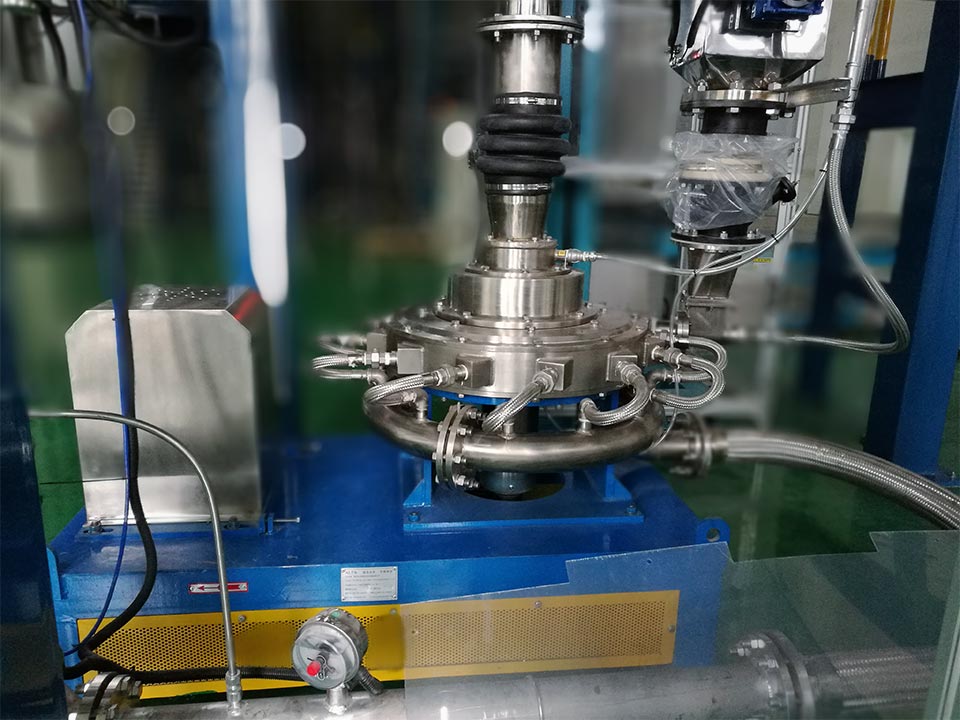
The fluidized-bed jet mill is a process where compressed air is accelerated by Laval nozzles into supersonic airflow, and then injected into the crushing zone to make the material fluidized (the airflow expands into a fluidized bed suspension and boiling and collides with each other), so each particle Have the same state of motion. In the crushing zone, the accelerated particles collide and crush at the intersection of the nozzles. The crushed materials are transported to the grading area by the ascending airflow, and the fine powder that meets the particle size requirements is screened out by the grading wheel, and the coarse powder that does not meet the particle size requirements is returned to the pulverizing area to continue pulverization. The qualified fine powder enters the high-efficiency cyclone separator along with the air flow to be collected, and the dust-containing gas is filtered and purified by the dust collector and discharged into the atmosphere.

The raw materials of the circulating tube jet mill are fed into the crushing chamber by nozzles, and the high-pressure air flow is sprayed into the racetrack-shaped circulating tube crushing chamber with unequal diameter and variable curvature through a set of nozzles, accelerating the particles to collide, collide and rub each other to crush. At the same time, the swirling flow also drives the crushed particles upwards into the classification zone along the pipeline, and the dense material flow is divided under the action of the centrifugal force field in the classification zone, and the fine particles are discharged after being classified by the louver-type inertial classifier in the inner layer. The coarse particles return along the descending pipe in the outer layer and continue to circulate and crush.
Jet mills are widely used in industries such as chemical industry, minerals, metallurgy, abrasives, ceramics, refractory materials, medicine, pesticides, food, health products, new materials and so on. This is inseparable from its remarkable performance advantages. The performance characteristics of the jet mill are as follows:
1. Variable combination structure: one machine for two purposes, which can be crushed or graded separately;
2. Multi-stage cascade: It can be connected with 1-5 classifiers to produce products with narrow particle size distribution;
3. Wide range of crushing particle size: The particle size of the finished product can be adjusted between D97=3-150 microns, and the particle shape is good;
4. The whole system is sealed and crushed, with less dust, low noise, and the production process is clean and environmentally friendly;
5. The program control system is adopted, and the operation is simple.
Important features of jet mill
The jet mill is the compressed air accelerated by the Laval nozzle into a supersonic airflow and then injected into the crushing zone to make the material fluidized (the airflow expands into a fluidized bed suspension and boiling and collides with each other), so each particle has the same state of motion .
As an important equipment for ultra-fine grinding, the jet mill has been widely used in chemical, pharmaceutical, battery materials, metallurgy, talc, quartz, graphite, abrasives, flame retardant materials, ceramics, pigments, food additives, pigments and other dry powder materials. Ultra-pure ultra-fine crushing.
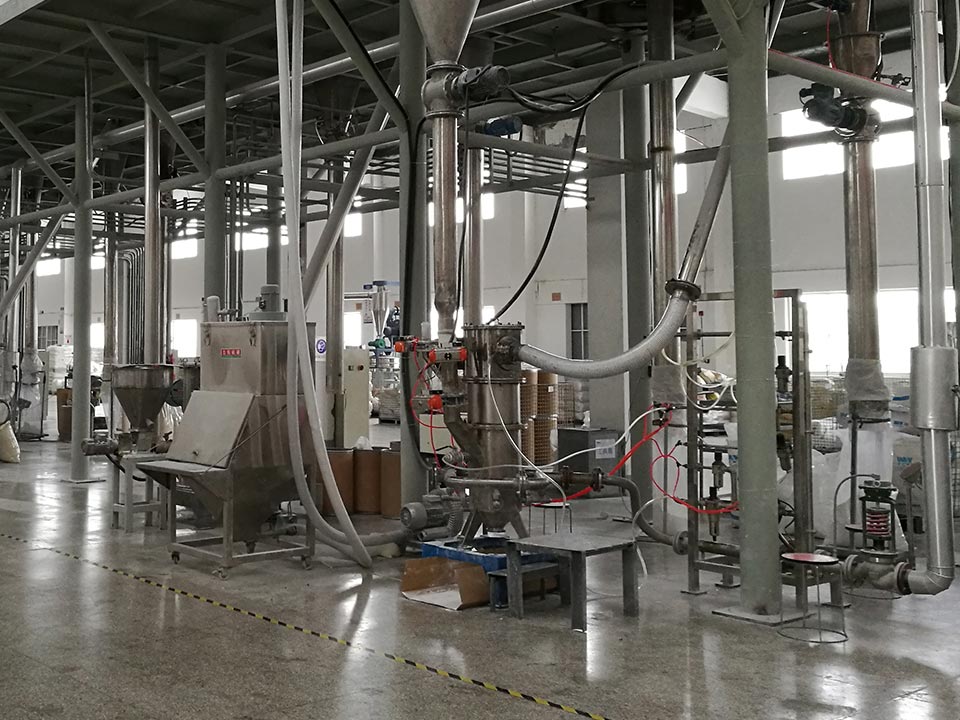
Features of jet mill
In addition to fine particle size, jet mill products also have the characteristics of narrow particle size distribution, smooth particle surface, regular particle shape, high purity, high activity, and good dispersibility.
Since the compressed gas is adiabatic during the crushing process, the expansion produces a Joule-Thomson cooling effect, so it is also suitable for ultrafine crushing of low-melting, heat-sensitive materials.
Working principle of jet mill
The dry and oil-free compressed air or superheated steam is sprayed at high speed through the nozzle, and the high-speed jet moves the animal material at a high speed, causing the material to collide, rub and crush. The pulverized materials arrive at the classification area with the airflow, and the materials that meet the fineness requirements are collected by the collector. The materials that do not meet the requirements are returned to the crushing chamber to continue crushing until they reach the required fineness and are collected.

Due to the high velocity gradient near the nozzle, most of the pulverization occurs near the nozzle. In the crushing chamber, the frequency of particle-to-particle collisions is much higher than that of particle-to-wall collisions. Therefore, the main crushing effect in jet mills is the impact or friction between particles.

